Last updated on March 22nd, 2022
Our site is reader supported, this means we may earn a small commission from Amazon and other affiliates when you buy through links on our site.
No matter what type of plant you have, cold winter weather, especially as temperatures drop below freezing, can cause serious damage. If you don’t make an effort to protect your plants from frost, it can cause permanent damage. Heavy wind, rain and snow can damage shrubs, trees and even garden structures.
Consider this: Heavy wind accompanying frost can uproot plants if they aren’t protected, while wet conditions with frost can result in rot, and kill the plant.
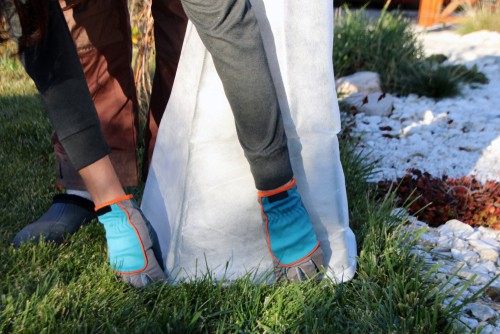
Wrap pots in bubble wrap or sacking and move more tender plants into a greenhouse
It is important to take it upon yourself to improve the available shelter for your plants, wrapping their pots, moving certain more tender plants indoors if possible, adding extra support structures, and even including things like mulch to help protect roots from hard frost as well as reducing compaction and soil erosion which is usually caused by heavy rain over winter.
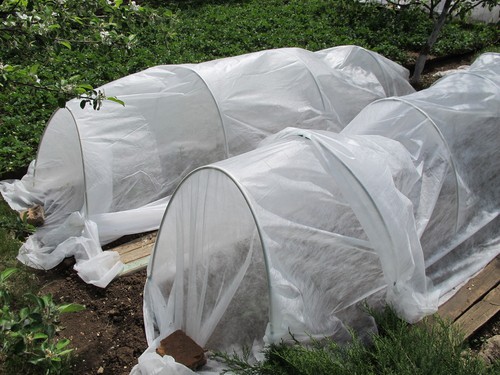
Protecting plants in cold areas and why milder winters increase the chances of frost damage
- In cold areas, all plants, even the hardiest of plants, might need some extra protection in the form of fleece and mulching around the base. Evergreens and potted plants are at a higher risk than those in the ground and will need additional care to avoid foliage damage and the freezing of roots of plants grown in pots.
- In milder areas where the temperatures are not as substantial, you can protect your plants from frost with simple coverings made from fleece which are very affordable. Mild winters might seem more appealing but they can prevent the deep dormancy that protects many trees and shrubs, and in so doing increases the susceptibility to frost damage brought about by sudden cold snaps or cold wind.
What can you do to help protect your plants over winter? Ideally, protection should be considered and acted upon as soon as we start to get frost.
Using protective wrappings such as fleece to protect plants
 Frost jackets for protecting plants – Buy from Amazon.co.uk
Frost jackets for protecting plants – Buy from Amazon.co.uk
One surefire way to protect your plants against frost is to give them a protective wrapping. This is a measure you should put into effect at the very first signs of frost. Plants that are in containers should be wrapped in fleece, container too, in a layer of protective bubble wrap or fabric lagging. The bubble wrap and insulation for ground-grown plants can help protect against direct exposure.  Plant protection fleece – Available from Amazon.co.uk
Plant protection fleece – Available from Amazon.co.uk
Horticultural fleece can be ordered and used year after year to protect the exposed parts of your plants against wet, cold weather. You can also buy winter protection jackets that fit over individual plants but you can also buy large lengths of fleece to cover whole borders if needed or larger plants.
Cultivation Practices
Another way to protect your plants is to plan ahead and implement cultivation practices that position your plants and grow them in sheltered spaces. This means thinking ahead before planting and deciding where to position particular plants before planting them, for example, plants that flower early such as Cammelias and Magnolias should be planted in a more sheltered position where the buds cannot be damaged by frost as easily.
Stop feeding nitrogen-heavy feeds after September as this produces growth that will be damaged by frost.
To give your plants a boost against frost damage, avoid feeding nitrogen-heavy fertiliser at the end of the season. This promotes fresh new growth that will be more suspectable to frost damage.
Help prevent soil leaching
You can prevent soil leaching of nutrients by sowing green manure in September. You can then dig them into the soil in spring to improve the soil. If you have a vegetable patch that is empty it’s also a good idea to cover it with black polythene, this can be done in early spring to help keep the soil a few degrees warmer ready for planting.
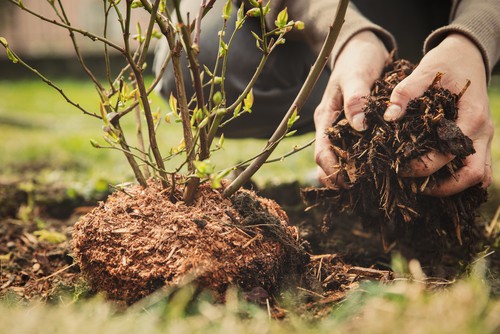
Mulch around the base of plants or full borders
Mulch can help protect the soil against the erosion that typically follows heavy rain, so if you have plants grown in the ground, layer the base with mulch before winter. This will also help to protect the roots from hard frost, puts nutrients back into the soil and also helps suppress weeds come spring. It can also work as a slug and snail deterrent. 
Mulch available from Amazon.co.uk – Buy now by clicking here
Plant hedges and screens to form protected areas in your garden
Strategically planting things like hedges against a part of your home you know is susceptible to heavy wind and cold will also help keep the rest of your garden warm.
Planning a protected garden by considering any south-facing positions
If possible, you should consider the layout of your garden before planting everything. This is particularly important if you live in an area where the winters are harsh and frost comes early, which in the UK is usually further north and into Scotland.
The garden layout will offer natural protection against frost damage. Consider that the base of a south-facing wall is going to be a warm spot whereas the north part of your home is more exposed to the cold. Select your plants according to their preference so that you can prevent serious frost damage.
Protecting container grown plants
If you are growing plants in containers and pots, move them to dry, sheltered areas whenever possible and of course, wrap them accordingly in fleece and bubble wrap. You might consider investing in a greenhouse where you can store your over-winter container plants to protect them the most.
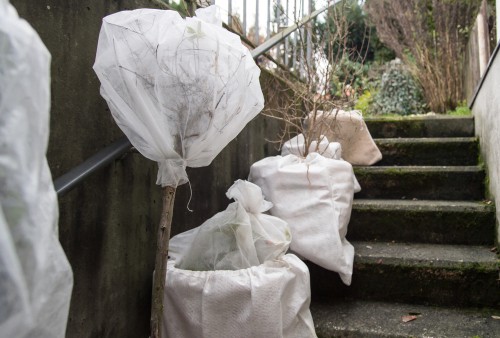
See our latest round-up of the best greenhouses here
See our guide on how to properly insulate a greenhouse in this article
Consider burying pots in the ground
If you cannot do this, you might be able to prevent frost damage by burying the pot in the ground, just to the point where the rim is showing. The ground soil will remain warmer in the winter than the exposed area above ground, and this can help protect certain plants from root damage.
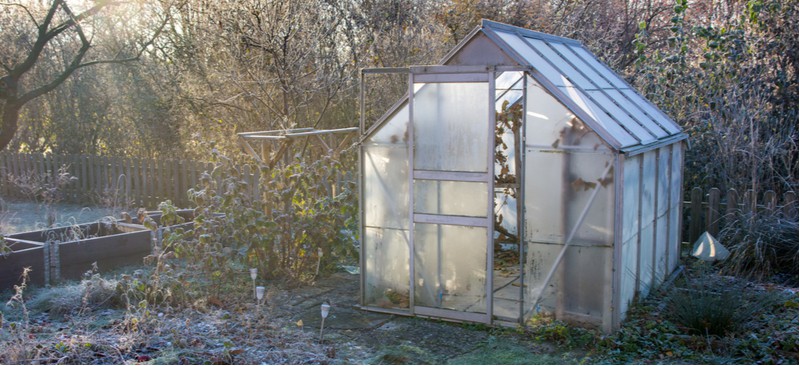
Group containers together
Assuming you have no space in which to bury them, and no greenhouse in which to move them, you can still protect against frost damage by placing them grouped together. If you can, move all of your pots together, huddled near one another for additional protection and warmth. Think of how people huddle together for warmth; effectively this is what you are doing for your plants. Simply position in the most sheltered position and cover with fleece and bubble wrap as we have already explained.
Other Tips
Fix structures, stakes and fences before winter
You can give your garden added protection by checking all the structures before the first frost, making any repairs you see are needed. Simple repairs to a fence to replace broken posts can make your fence stronger against the wind and as a result, protect plants, many plants are damaged every winter caused by weak fence panels crushing them.
Improve drainage if needed
Also, correct any drainage problems before the weather turns. If you have drainage problems and wet soil, younger plants or those with shallow roots are more likely to get uprooted in wind storms or die from being too waterlogged and the water freezing.
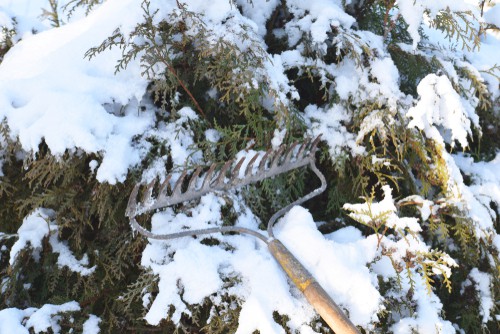
Remove snow from trees, hedges and large shrubs
If it snows in your area, do not let the snow sit on the crowns of trees or hedges because it can break the branches. If it snows, remove the excess snow once you see it building up on your branches, and try to prune hedges in a tapered fashion to minimise any snow accumulation and subsequent damage.
Overall, if you live in an area with regular winter temperatures, no matter how cold they are, you can plan ahead of time more easily than a location that experiences fluctuating temperatures. For example, if you are moving to an area where the winters are always cold with heavy frost, you can invest in long-term solutions like hedges, horticultural fleece, greenhouses or permanent structures to protect against severe wind. If you live in a warmer area a solution in which you invest might be more short-term.
Still, no matter what, it’s important to be prepared for all types of extreme weather. Just because you have had mild winters in recent years doesn’t mean that next year will be the same, and vice versa. Are you ready for winter?


